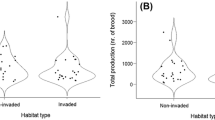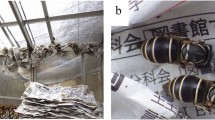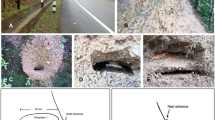Abstract
The paper presents the results of analysis of the relationships of various colony characteristics in the resocial wasp Polistes dominula nesting on plants in the south of Ukraine (Kherson Province, the Black Sea Biosphere Reserve) in 2003–2007. The number of future foundresses and nest size at the end of the life cycle depend on the queen longevity and on the number of workers in the colony. The number of males reared in the colony is positively correlated with the nest size (the number of cells) and negatively correlated with the queen longevity. An increase in the share of the brood infested by the parasitoids Latibulus argiolus (Hymenoptera, Ichneumonidae) and Elasmus schmitti (Hymenoptera, Eulophidae) results in a smaller nest size and a smaller number of males reared.
Similar content being viewed by others
References
Beggs, J.R., Brockerhoff, E.G., Corley, J.C., et al., “Ecological Effects and Management of Invasive Alien Vespidae,” BioControl 56 (4), 505–526 (2011).
Begon, M., Harper, J.L., and Townsend, C.R., Ecology. Individuals, Populations and Communities (Blackwell Sci. Publ., Oxford, 1986; Mir, Moscow, 1989) [in Russian].
Cervo, R., Zacchi, F., and Turillazzi, S., “Polistes dominulus (Hymenoptera: Vespidae) Invading North America; Some Hypotheses for Its Rapid Spread,” Ins. Soc. 47 (2), 155–157 (2000).
Inagawa, K., Kojima, J., Sayama, K., and Tsuchida, K., “Colony Productivity of the Paper Wasp Polistes snelleni: Comparison between Cool-Temperate and Warm-Temperate Populations,” Ins. Soc. 48 (3), 259–265 (2001).
Itô, Y. and Itioka, T., “Demography of the Okinawan Eusocial Wasp Ropalidia fasciata (Hymenoptera: Vespidae) II. Effects of Queen Group Size on Survival Rates of Colonies and Queens, and Production of Progeny,” Entomol. Sci. 11 (1), 17–30 (2008).
Gamboa, G.J., “Intraspecific Defense: Advantage of Social Cooperation among Paper Wasps Queens,” Science 199, 1463–1465 (1978).
Gamboa, G.J., “Comparative Timing of Brood Development between Multiple- and Single-Queen Colonies of the Paper Wasp, Polistes metricus,” Ecol. Entomol. 5 (3), 221–225 (1980).
Gamboa, G.J., Wacker, T.L., Duffy, K.G., et al., “Defense against Intraspecific Usurpation by Paper Wasp Coqueens (Polistes fuscutus, Hymenoptera: Vespidae),” Canad. J. Zool. 70 (12), 2369–2372 (1992).
Gamboa, G.J., Grieg, E.I., and Thom, M.C., “The Comparative Biology of Two Sympatric Paper Wasps, the Native Polistes fuscatus and the Invasive Polistes dominulus (Hymenoptera, Vespidae),” Ins. Soc. 49 (1), 45–49 (2002).
Gamboa, G.J., Noble, M.A., Thom, M.C., et al., “The Comparative Biology of Two Sympatric Paper Wasps in Michigan, the Native Polistes fuscatus and the Invasive Polistes dominulus (Hymenoptera, Vespidae),” Ins. Soc. 51 (2), 153–157 (2004).
Gamboa, G.J., Austin, J.A., and Monnet, K.M., “Effects of Different Habitats on the Productivity of the Native Paper Wasp Polistes fuscatus and the Invasive, Exotic Paper Wasp Polistes dominulus (Hymenoptera: Vespidae),” Great Lakes Entomol. 38 (3–4), 170–176 (2005).
Gibo, D.L., “The Selective Advantage of Queen Associations in Polistes fuscatus (Hymenoptera: Vespidae): a Field Study of the Effects of Predation on Productivity,” Canad. Entomol. 110 (5), 519–540 (1978).
Glantz, S.A., Primer of Biostatistics, 4th ed. (McGraw- Hill Inc., New York, 1997; Praktika, Moscow, 1999) [in Russian].
Gobbi, N. and Zucchi, R., “On the Ecology of Polistes versicolor versicolor (Oliver) in Southern Brazil (Hymenoptera, Vespidae, Polistini). II. Colonial Productivity,” Naturalia 10, 21–25 (1985).
Grechka, E.O. and Kipyatkov, V.E., “The Seasonal Development Cycle and Caste Determination in the Social Wasp Polistes gallicus L. (Hymenoptera, Vespidae). II. Growth Dynamics and Colony Productivity,” Zool. Zh. 63 (1), 81–94 (1984).
Gumovsky, A., Rusina, L., and Firman, L., “Bionomics, Morphological and Molecular Characterization of Elasmus schmitti and Baryscapus elasmi (Hymenoptera: Chalcidoidea, Eulophidae), Parasitoids Associated with a Paper Wasp, Polistes dominulus (Vespoidea, Vespidae),” Entomol. Sci. 10, 21–34 (2007).
Jeanne, R.L. and Morgan, R.C., “The Influence of Temperature on Nest Site Choice and Reproductive Strategy in a Temperate Zone Polistes Wasp,” Ecol. Entomol. 17 (2), 135–141 (1991).
Liebert, A., Sumana, A., and Starks, P.T., “Diploid Males and Their Triploid Offspring in the Paper Wasp Polistes dominulus,” Biol. Letters 1 (2), 200–203 (2005).
Liebert, A.E., Gamboa, G.J., Stamp, N.E., et al., “Genetics, Behavior and Ecology of a Paper Wasp Invasion: P. dominulus in North America,” Ann. Zool. Fenn. 43, 595–624 (2006).
Liebert, A.E., Wilson-Rich, N., Johnson, C., and Starks, P.T., “The Selective Sex Lives of Paper Wasps: Mate Choice and Nestmate Recognition in Polistes dominulus,” Ins. Soc. 57, 457–463 (2010).
Madden, A.A., Davis, M.M., and Starks, P.T., “First Detailed Report of Brood Parasitoidism in the Invasive Population of the Paper Wasp Polistes dominulus (Hymenoptera, Vespidae) in North America,” Ins. Soc. 57, 257–260 (2010).
Makino, S., “Biology of Latibulus argiolus (Hymenoptera: Ichneumonidae), a Parasitoid of the Paper Wasp Polistes biglumis (Hymenoptera: Vespidae),” Kontyû 51 (3), 426–434 (1983).
Mead, F., Habersetzer, C., Gabouriaut, D., and Gervet, J., “Dynamics of Colony Development in the Paper Wasp Polistes dominulus Christ (Hymenoptera, Vespidae): The Influence of Prey Availability,” J. Ethol. 12 (1), 43–51 (1994).
Mead, F. and Pratte, M., “Prey Supplementation Increases Productivity in the Social Wasp Polistes dominulus Christ (Hymenoptera Vespidae),” Ethol. Ecol. Evol. 14 (2), 111–128 (2002).
Nadeau, H. and Stamp, N., “Effect of Prey Quantity and Temperature on Nest Demography of Social Wasps,” Ecol. Entomol. 28 (3), 328–339 (2003).
Naug, D. and Wenzel, J., “Constraints on Foraging Success due to Resource Ecology Limit Colony Productivity in Social Insects,” Behav. Ecol. Sociobiol. 60 (1), 62–68 (2006).
Pickett, K.M. and Wenzel, J.W., “High Productivity in Haplometrotic Colonies of the Introduced Paper Wasp Polistes dominulus (Hymenoptera: Vespidae; Polistinae),” J. New York Entomol. Soc. 108 (3), 314–325 (2000).
Rore Team, R: a Language and Environment for Statistical Computing (R Foundation for Statistical Computing, Vienna, 2013), http://www.r-project.org/ (accessed 1.02.2014).
Röseler, P.-F., “Reproductive Competition during Colony Establishment,” in The Social Biology of Wasps, Ed. by K.G. Ross and R.W. Matthews (Cornell Univ. Press, London, 1991), pp. 309–335.
Rusina, L.Yu., Polistine Wasps in Natural and Anthropogenic Landscapes of the Lower Dnieper Basin (Kherson State Univ., Kherson, 2006) [in Russian].
Rusina, L.Yu., “Reaction of Parasitoids of the Paper Wasp Polistes dominulus (Christ) (Hymenoptera, Vespidae, Polistinae) to the Host Distribution,” Entomol. Obozr. 87 (3), 514–536 (2008) [Entomol. Rev. 88 (8), 881–897 (2008)].
Rusina, L.Yu., “Structural and Functional Organization of Paper Wasp Populations (Hymenoptera: Vespidae),” Trudy Russ. Entomol. O-va 79, 1–217 (2009).
Rusina, L.Yu., “Self-Organization of Populations of Polistine Wasps (Hymenoptera, Vespidae, Polistinae),” Entomol. Obozr. 89 (2), 295–319 (2010) [Entomol. Rev. 90 (7), 811–829 (2010)].
Rusina, L.Yu., “Productivity of Colonies of the Wasp Polistes gallicus (L.) (Hymenoptera, Vespidae) in Different Parts of Its Range,” Kavkaz. Entomol. Byull. 7 (1), 95–100 (2011).
Rusina, L.Yu. and Skorokhod, O.V., “The Workers’ Mating and Female-Producing Eggs in the Orphaned Colonies of the Polistes dominulus Paper-Wasps (Hymenoptera, Vespidae) in the Black Sea Reserve,” Vestnik Zool. 39 (1), 70 (2005).
Silagi, S.A., Gamboa, G.J., Klein, C.R., and Noble, M.A., “Behavioral Differences between Two Recently Sympatric Paper Wasps, the Native Polistes fuscatus and the Invasive Polistes dominulus,” Great Lakes Entomol. 36 (3–4), 99–104 (2003).
Strassmann, J.E., “Parasitoids, Predators, and Group Size in the Paper Wasp, Polistes exclamans,” Ecology 62 (5), 1225–1233 (1981).
Strassmann, J.E., “Worker Mortality and the Evolution of Castes in the Social Wasp, Polistes exclamans,” Ins. Soc. 32, 275–285 (1985).
Tibbetts, E.A. and Reeve, H.K., “Benefits of Queen Associations in the Paper Wasp Polistes dominulus: Increased Productivity and Survival, but no Assurance of Fitness Returns,” Behav. Ecol. 14 (4), 510–514 (2003).
Turillazzi, S., Marino-Piziolli, M.T., Hervatin, L., and Pardi, L., “Reproductive Capacity of Single Queen and Associated Queen Females of Polistes gallicus (L.) (Hymenoptera, Vespidae),” Monit. Zool. Ital. 16 (1), 75–88 (1982).
Wilson-Rich, N. and Starks, P.T., “The Polistes War: Weak Immune Function in the Invasive Polistes dominulus Relative to the Native P. fuscatus,” Ins. Soc. 57, 47–52 (2010).
Wheeler, R.E., LmPerm. Permutation Tests for Linear Models in R. R Package Version 1.1-2 (2010), http://cran.r-project.org/src/contrib/Archive/lmPerm/ (accessed 1.02.2014).
Author information
Authors and Affiliations
Corresponding author
Additional information
Original Russian Text © L.Yu. Rusina, M.A. Ghazali, L.A. Firman, 2016, published in Entomologicheskoe Obozrenie, 2016, Vol. 95, No. 1, pp. 28–33.
Rights and permissions
About this article
Cite this article
Rusina, L.Y., Ghazali, M.A. & Firman, L.A. Colony productivity of Polistes dominula (Christ) (Hymenoptera, Vespidae: Polistinae) wasps nesting on plants by haplometrosis: Regression analysis. Entmol. Rev. 96, 160–167 (2016). https://doi.org/10.1134/S0013873816020032
Received:
Published:
Issue Date:
DOI: https://doi.org/10.1134/S0013873816020032




